Does providing information on geoengineering reduce climate polarization?
Dan Kahan of Yale University and four colleagues have just published an article in Annals of the AAPS titled: Geoengineering and Climate Change Polarization Testing a Two-Channel Model of Science Communication that investigates the effect on study participants' attitudes to climate change after reading an article about geoengineering. In their abstract, they write:
We found that cultural polarization over the validity of climate change science is offset by making citizens aware of the potential contribution of geoengineering as a supplement to restriction of CO2 emissions.
I will argue here that this experiment achieved no such result because the premise was wrong. Specifically, the information on geoengineering that was presented to the study participants (in the form of a fictional newspaper article) bears no relation to mainstream scientific opinion on geoengineering nor, even, to the opinions of advocates of geoengineering. Geoengineering is portrayed in the fictional newspaper article as a strategy with no uncertainty about how well it might work and, it is claimed, will "spare consumers and businesses from the heavy economic costs associated with the regulations necessary to reduce atmospheric CO2 concentrations to 450 ppm or lower". This is hardly depicting geoengineering as a "potential solution" or "a supplement" to the restriction of emissions, as is claimed in the abstract of the paper.
In fact, what Kahan et al. have demonstrated is that presenting misinformation dressed up as fact can affect people's opinions about climate change. That may be interesting as a social science experiment conducted on consenting adults, but it is not much use as a guide to effective public science communication, constrained as it is to tell the truth.
The Kahan et al 2015 paper is paywalled, but there is a 2012 version of it (updated in 2015), with the same title, similar figures, but different text, that is available online here. The study looked at two representative samples of individuals from the USA and England of 1500 each. The two samples were further split into three groups that were each asked to read one of three fictional newspaper articles. One article, used as a control, had nothing to do with climate change. The second was an article advocated tighter limits on atmospheric concentrations of CO2 (although this article contained what surely must be a typo, calling for CO2 concentrations of 175 ppm, which would send us back to depths of the last ice age). The third piece called for geoengineering on the grounds that "limiting emissions is a wasteful and futile strategy". Articles two and three both quoted a (fictional) Dr Williams of Harvard University, the spokesman of the (fictional) "American Association of Geophysical Scientists". Both of these articles contained a couple of pictures designed to appeal to or to repel people at either end of the political spectrum.
All participants were then asked to read a piece from the (fictional) journal Nature Science. The fake article was cobbled together from various real scientific publications and was policy-neutral. The participants were then asked to evaluate this article for its validity and their own assessment of climate change risk.
You can read the articles for yourself on pages 30-33 here. I have copied the geoengineering piece below:
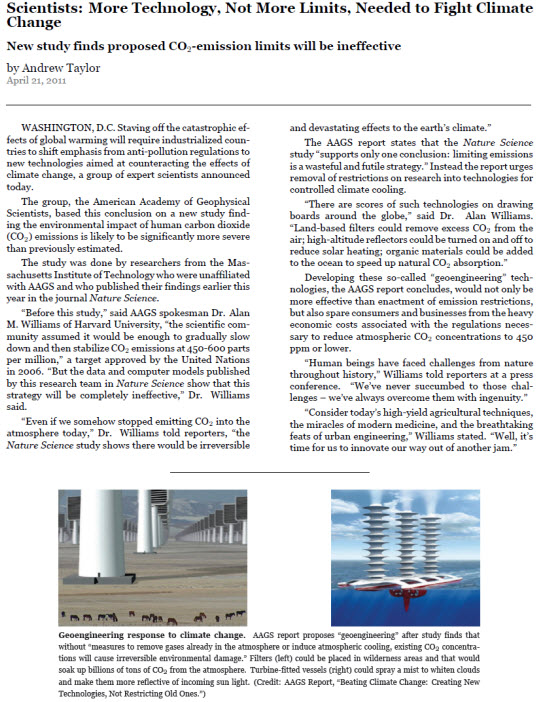
This account of the costs and benefits of geoengineering echoes the simplistic and widely debunked account of geoengineering in the book SuperFreakonomics. It bears little resemblance to what mainstream scientists—even the geoengineering enthusiasts among them—say. Note, in particular, the claim that geoengineering would spare consumers the costs and regulations of emissions reduction. The National Academy of Sciences (NAS) in a recent report estimates that the cost of direct air capture of CO2 of the kind shown in the left-hand picture would cost $400-1000 per tonne of CO2, which is much higher than generally accepted emissions mitigation costs. The albedo modification technology shown in the right-hand picture (incorrectly referred to as a "flying" rather than floating vessel in the text of the paper) would require international regulation for it to be done responsibly, if indeed it could ever be done safely at all.
What do actual climate scientists say about geoengineering?
It's probably worthwhile first to distinguish between the two main types of geoengineering, which have very different cost, effectiveness and risk profiles.
Solar radiation management or albedo modification is cheap and poses regional and global risks. Harvard University scientist David Keith estimates that an effective program could be achieved by spending of the order of $1 billion per year, employing a fleet of twenty or so modified business jets to spray sulphuric acid into the stratosphere. To put that sum into perspective, if the Koch brothers invested $50 billion of their fortune in Treasury Bills, they could fund global solar radiation management in perpetuity out of the interest alone. Some of the shortcomings and perils of this kind of intervention are detailed in Alan Robock's article 20 reasons why geoengineering may be a bad idea. Most importantly, albedo modification does nothing to avert ocean acidification.
Carbon dioxide removal is expensive and poses mainly local risks. It comprises three main technologies:
- carbon capture and sequestration (CCS) where CO2 is captured at source from the exhausts of fossil-fuel power plants;
- direct air capture and sequestration (DACS), in which CO2 is removed from ambient air by a variety of so-far untested technologies and;
- bio-energy CCS (BECCS) involving CO2 capture at bio-energy power plants. CCS and BECCS are relied upon heavily in the socio-economic model underlying the IPCC's only projection (RCP2.6) that avoids exceeding 2 degrees Celsius of warming. See for example van Vuuren et al. (2011).
Here is a handy summary table from the NAS report:
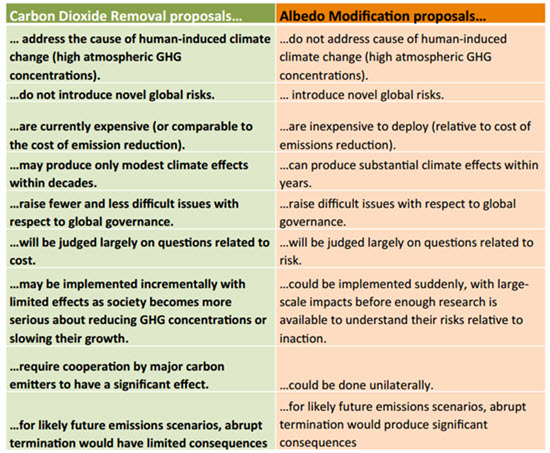
There is no consensus among scientists about what to do about geoengineering. Near one end of the scale we have David Keith, a Harvard scientist and a leading advocate for the serious consideration of geoengineering, who has written in the preface to his recent book (which I recommend): A Case for Climate Engineering:
I myself have concluded that it makes sense to move with deliberate haste towards deployment of geoengineering. You may well reach a different conclusion. My goal is simply to convince you that it’s a hard choice.
However, this comment was introduced with the kind of caveats missing from the fictitious newspaper article and the quotes from "Dr Alan Williams" of Harvard University. Keith:
Solar geoengineering is a set of emerging technologies to manipulate the climate. These technologies could partially counteract climate change caused by the gradual accumulation of carbon dioxide. Deliberately adding one pollutant to temporarily counter another is a brutally ugly technical fix, yet that is the essence of the suggestion that sulfur be injected into the stratosphere to limit the damage caused by the carbon we’ve pumped into the air.
Solar geoengineering is an extraordinarily powerful tool. But it is also dangerous. It entails novel environmental risks. And, like climate change itself, its effects are unequal, so even if it makes many farmers better off, others will be worse off. It is so cheap that almost any nation could afford to alter the earth’s climate, a fact that may accelerate the shifting balance of global power, raising security concerns that could, in the worst case, lead to war. If misused, geoengineering could drive extraordinarily rapid climate change, imperiling global food supply. In the long run, stable control of geoengineering may require new forms of global governance and may prove as disruptive to the political order of the 21st century as nuclear weapons were for the 20th.
Other climate scientists are less keen on geoengineering than David Keith. In a recent Slate piece: Climate Hacking Is Barking Mad, University of Chicago climate scientist Ray Pierrehumbert writes:
In other words, albedo modification addresses (albeit imperfectly) the symptoms but not the root causes of CO2-induced global warming. As a possible response to such criticisms, Oxford’s Steve Rayner has mused that “Band-Aids are useful when you are healing.” However, Band-Aids are not all that useful if you really needed penicillin instead, and the wound festers until you die. Albedo modification is not like a bandage that promotes healing, but more like taking painkillers when you really need surgery for cancer.
...
Now, about those research recommendations: If albedo modification is such a terrible idea, why do research on it at all? Indeed in his book, Mike Hulme considers the technology ungovernable and argues that if a technology is basically ungovernable at the level of deployment, we shouldn’t be doing research that could bring it into being.
Ethicist Clive Hamilton has written a book about geoengineering Earthmasters The Dawn of the Age of Climate Engineering, which I recommend as a counterpoint to Keith's book. Hamilton takes a critical look at the motives of those advocating geoengineering and describes how climate modification was originally researched in weapons laboratories in the USA.
Regardless or whether or not we chose to emphasize information on geoengineering in climate communications, the issue is not likely to go away, at least until the world has embarked on meaningful emission mitigation measures. It's as if we are in the second act of a Chekhov play, in which the gun that appeared in the first act is destined to go off in the third. David Keith is probably right in his observation that geoengineering will be as disruptive for global governance in this century as nuclear weapons have been since 1945.
Polarization
The headline result, to recap, from the Kahan et al. study is that:
We found that cultural polarization over the validity of climate change science is offset by making citizens aware of the potential contribution of geoengineering as a supplement to restriction of CO2 emissions.
I hope that I have demonstrated that the subjects were actually fed misinformation that instead portrayed geoengineering as a low cost, risk-free substitute for the restriction of emissions.
Many people who are opposed to accepting climate change have deep-seated concerns that mitigation solutions will require taxation, loss of liberty and the handing over of control to a technocratic elite with whom they do not share a cultural or even national identity. In order for geoengineering to be safely deployed, even its proponents stipulate that we will need:
• Carbon pricing, in some form to pay for carbon dioxide removal. Ultimately, carbon removal and sequestration has to be funded by fossil-fuel consumers or taxpayers. It won't be cheap.
• Global governance agreements to decide whose fingers get to control the albedo modification thermostat, along with some kind of mechanism to compensate the losers from climate intervention, since its regional effects will be far from uniformly benign.
• A climate model that reliably predicts the regional changes that will result from deliberate climate modification. This model would have to be endorsed by a consensus of the planet's climate experts. Current models don't come close to this level of precision or reliability.
Kahan's subjects were not told any of this and my guess is that the "Hierarchical Individualist" group (who are inclined to doubt mainstream climate science) would have been less keen on it had they been made fully aware of what geoengineering involves in terms of taxation, world government, handing over of control to a global scientific elite and reliance on a hugely complex climate model.
Here's the effect that Kahan et al. observed on cultural polarization:
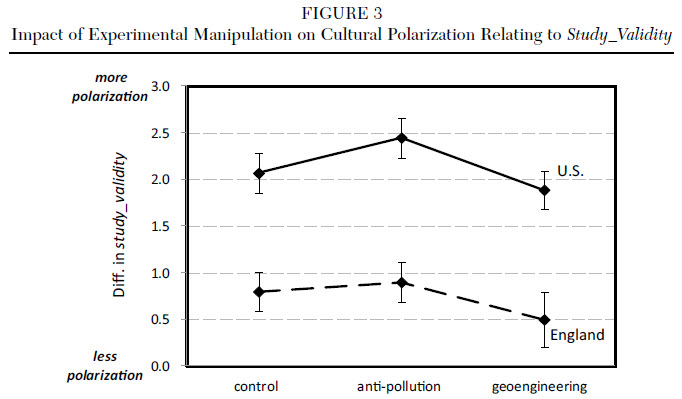
The US and English participants showed slightly less polarization after they had been exposed to geoengineering than the control group did. The anti-pollution message increased polarization. The error bars overlap considerably. But for me the most striking thing about this graph is how much worse the polarization is in the USA compared to England. It seems unlikely that this trans-Atlantic gap on cultural polarization over climate could be caused by the information the participants are hearing. The English are exposed to essentially the same communications that Americans are (e.g., the IPCC, the Murdoch press), yet they are far less polarized on this issue.
Britain's political leaders recently—and apparently happily—made a joint declaration on climate policy.
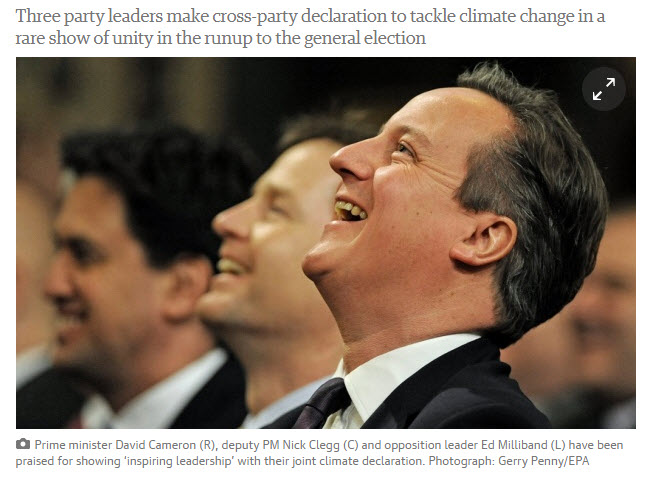
Not only is political polarization on climate mainly an American problem, but it's a relatively recent American problem. Famously, Newt Gingrich and Nancy Pelosi shared a sofa on a rainy day in Washington in 2008 and saw eye-to-eye on climate change. But things have changed since then, with increased polarization on climate and on many other policy issues. It is perhaps futile to look for a climate communication solution to a problem that was not caused by climate communications in the first place.
Goodbye blue sky
One consequence of undertaking solar radiation management is that it will change the colour of clear skies from blue to a more milky shade. And that change will endure for as long as we need to keep on cooling the planet, essentially forever. Of all the reasons to be wary of geoengineering, this is probably the least serious from a human welfare standpoint, but it's possibly the one that will strike many people the strongest. One of the problems of raising awareness about carbon dioxide pollution is that it is invisible. In contrast, the albedo modification "cure" for the pollution problem will be visible to everyone.
We should not assume that geoengineering has some kind of automatic appeal to people inclined to reject climate change. In fact, a poll done by the Brookings Institute found the opposite.
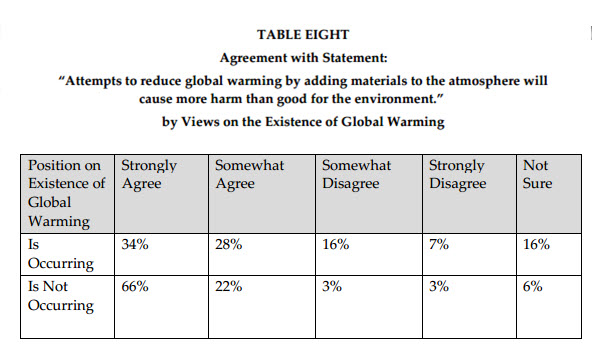
People who take the position that global warming is not occurring are overwhelmingly in agreement that adding materials to the atmosphere will cause more harm than good. My own (anecdotal) observations of climate change contrarian blogs are that, although their denizens are typically eager to consider a wide range of unconventional scientific ideas, there is generally little enthusiasm among them for geoengineering.
A comment by one of the Brookings Institute poll's authors, Barry Rabe, reported in Scientific American, was that peoples' minds are generally made up, one way or the other, on geoengineering.
But what is interesting about the new results, Rabe said, is that few respondents indicated they were neutral about geoengineering.
"One thing that surprised us a bit is the percentage of people who responded with an opinion," he said. "In every case, we gave them the option to say 'not sure.' I frankly expected more people to punt on this one."
There seems to be a popular and deep-rooted fear among people of all cultural persuasions with the idea of deliberately tinkering with the climate. For every techno-optimist who imagines a bright shiny future where the Earth's climate is successfully micromanaged, there is probably a techno-pessimist who imagines the future under deliberate climate modification to look something like the apocalyptic vision (of the London Blitz) in the video of the Pink Floyd song titled, oddly enough, Goodbye Blue Sky.
So, in conclusion, returning to the question posed in the title of this piece: Does providing information on geoengineering reduce climate polarization?
The answer is: we don't know, because the lab experiment that measures the reactions of people exposed to realistic information on geoengineering has not yet been done. But as the future unfolds in the real world we will likely find out anyway: the question of whether we should deliberately attempt to ameliorate the climate crisis with technological interventions is not going to go away. Perhaps the best we can hope for is that the prospect of the limited benefits, uncertain outcomes and unpleasant side-effects of this drastic course of treatment for the climate disease might indeed motivate everyone to come together to focus on preventing the symptoms from becoming ever worse.
Posted by Andy Skuce on Wednesday, 4 March, 2015






